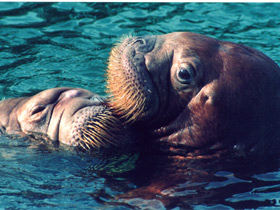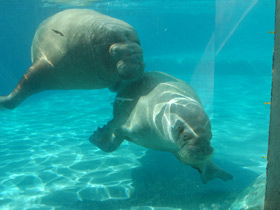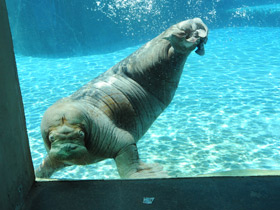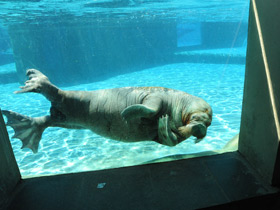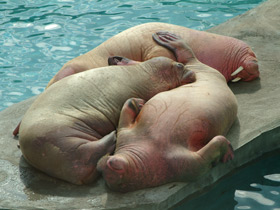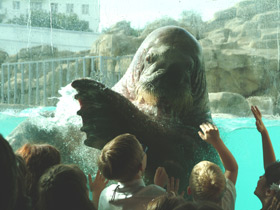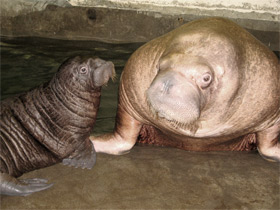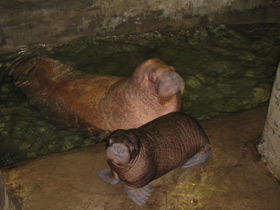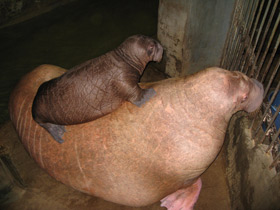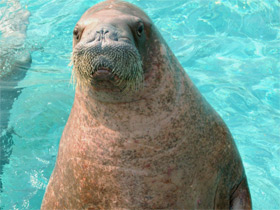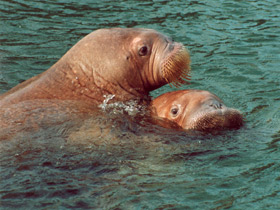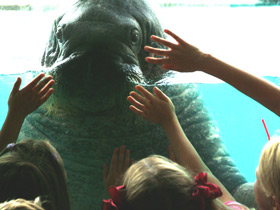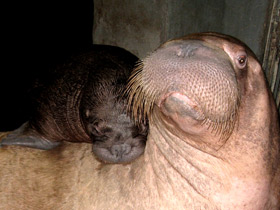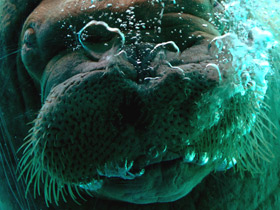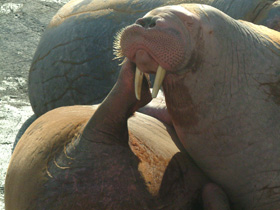The walrus (Odobenus rosmarus)
 The walrus (Odobenus rosmarus) is included in the IUCN Red List as a "vulnerable species"
The walrus (Odobenus rosmarus) is included in the IUCN Red List as a "vulnerable species"
The walrus (Odobenus rosmarus) is a large pinniped marine mammal with discontinuous distribution about the North Pole in the Arctic Ocean and subarctic seas of the Northern Hemisphere. It is the only extant species in the family Odobenidae and genus Odobenus. This species is subdivided into two subspecies: the Atlantic walrus (Odobenus rosmarus rosmarus), which lives in the Atlantic Ocean, and the Pacific walrus (Odobenus rosmarus divergens), which lives in the Pacific Ocean.
Adult walrus are characterised by prominent tusks and whiskers, and considerable bulk: adult males in the Pacific can weigh more than 2,000 kilograms (4,400 pounds) and, among pinnipeds, are exceeded in size only by the two species of elephant seals. Walrus live mostly in shallow waters above the continental shelves, spending significant amounts of their lives on the sea ice looking for benthic bivalve molluscs. Walruses are relatively long-lived, social animals, and are considered to be a "keystone species" in the Arctic marine regions.
The walrus has played a prominent role in the cultures of many indigenous Arctic peoples, who have hunted it for meat, fat, skin, tusks, and bone. During the 19th century and the early 20th century, walrus were widely hunted for their blubber, walrus ivory, and meat. The population of walruses dropped rapidly all around the Arctic region. It has rebounded somewhat since, though the populations of Atlantic and Laptev walruses remain fragmented and at low levels compared with the time before human interference.
Description
Odobenus rosmarus is a species of pinniped mammal in the family Odobenidae. There are two subspecies, the Atlantic walrus (Odobenus rosmarus rosmarus rosmarus) and the Pacific walrus (Odobenus rosmarus divergens). The world walrus population is estimated at about 250,000 individuals.
Walruses belong to the order Carnivora and the suborder (or, according to others, superfamily) Pinnipedia.
Odobenus rosmarus is the largest pinniped in the northern hemisphere. The average size of females is 2.6 m at about 500 kg, while that of males is 3-3.5 m at 750 kg (up to a maximum of 1270 kg). The body of Odobenus rosmarus is very massive, the skin is thick and covered with wrinkles and folds, the limbs are broad, the head is relatively small and there are no external ear pinnae. On land, they move rather awkwardly, relying on their four limbs. However, Odobenus rosmarus has very flexible flippers: it can freely scratch its neck with its hind legs. And in the water, its incredibly massive body has an unexpected plasticity and mobility for such a giant.
Odobenus rosmarus has a broad snout and a striking set of hard but sensitive whiskers (vibrissae), which arise from thick fleshy "pillows" on the upper lip, arranged in 13-14 rows and reaching 10-12 cm in length.
The name "odobenus" comes from Greek and means "walking with the teeth". They received the name Odobenus rosmarus because they use their tusks as an ice axe when climbing on slippery ice floes.
The tusks are modified tusks, which have a length of 30-40 cm in females and 40-50 cm in males, occasionally up to 80 cm. They serve as a universal tool for Odobenus rosmarus: a spatula for pulling shells from the seabed, a support for a heavy head, a weapon for fighting rivals and for protection from polar bears. Unfortunately, in zoos the tusks of Odobenus rosmarus wear out quickly and often have to be removed.
Nutrition
Odobenus rosmarus feeds mainly on molluscs, but also on crustaceans, ringworms, holothurians, starfish, and may occasionally catch fish. Individuals, called "keluchi" by the Chukchi, specialise in feeding on warm-blooded animals: narwhals, beluga whales, seals and birds. Walruses dig up molluscs by slanting backwards, furrowing the bottom with their tusks and pulling up layers of soil from the bottom, or catch them by burrowing through dense thickets of seaweed or between rocks with their vibrissae. These animals wash the shells buried in the silt with a jet of water, which they release forcefully from their mouths. Then, holding the shell with its vibrissae, Odobenus rosmarus sucks the body of the mollusc.
Breeding
During the breeding season, Odobenus rosmarus gather in colonies. They do not form harems, but stay in family groups of 3 to 6 animals, consisting of a male, a female and cubs of different ages. Unlike other pinnipeds, in the colonies Odobenus rosmarus tries to lie as close together as possible, not because of lack of space, but consciously. Even in areas with free space, the herd does not disperse along the coast, but stays together; similar to the way animals behave in zoos.
The reproduction rate of Odobenus rosmarus is extremely low. The gestation period is up to 16 months, and the female gives birth to a single calf approximately 1 m long and weighing 60 kg every 3-4 years. The colouration of the small Odobenus rosmarus is darker than that of adult walruses.
The female is very attached to her calf and always actively protects it. The calf knows how to swim from the first days of its life and, in case of danger, leaves the ice floe with its mother. If, for some reason, the calf is unable to do so, the mother stays by its side, even if it is in danger of death. If the calf gets tired, the mother usually "rolls it over" on its back. Even after learning to swim, the calves do not reject such wonderful transport and continue to climb onto the mother's back or scruff, holding on to her with their flippers. The female feeds her young with milk for a long time, up to two years. Only when the pup develops long fangs does it start to feed itself, but it remains attached to its mother for about a year.
Special features
Odobenus rosmarus are very intelligent, curious and friendly animals; at the Moscow Zoo they often look at visitors through the glass with great interest. In captivity, walruses are perfectly tame and very attached to their keepers, they can learn many commands.
Predators
Due to its great size and tusks, the walrus has only two natural predators: the orca and the polar bear. The walrus does not, however, comprise a significant component of either of these predators' diets. Both the orca and the polar bear are also most likely to prey on walrus calves. The polar bear often hunts the walrus by rushing at beached aggregations and consuming the individuals crushed or wounded in the sudden exodus, typically younger or infirm animals. The bears also isolate walruses when they overwinter and are unable to escape a charging bear due to inaccessible diving holes in the ice. However, even an injured walrus is a formidable opponent for a polar bear, and direct attacks are rare. Armed with its ivory tusks, walruses have been known to fatally injure polar bears in battles if the latter follows the other into the water, where the bear is at a disadvantage. Polar bear–walrus battles are often extremely protracted and exhausting, and bears have been known to break away from the attack after injuring a walrus. Orcas regularly attack walruses, although walruses are believed to have successfully defended themselves via counterattack against the larger cetacean. However, orcas have been observed successfully attacking walruses with few or no injuries.
Taxonomy and evolution
The walrus is a mammal in the order Carnivora. It is the sole surviving member of the family Odobenidae, one of three lineages in the suborder Pinnipedia along with true seals (Phocidae) and eared seals (Otariidae). While there has been some debate as to whether all three lineages are monophyletic, i.e. descended from a single ancestor, or diphyletic, recent genetic evidence suggests all three descended from a caniform ancestor most closely related to modern bears. Recent multigene analysis indicates the odobenids and otariids diverged from the phocids about 20–26 million years ago, while the odobenids and the otariids separated 15–20 million years ago. Odobenidae was once a highly diverse and widespread family, including at least twenty species in the subfamilies Imagotariinae, Dusignathinae and Odobeninae. The key distinguishing feature was the development of a squirt/suction feeding mechanism; tusks are a later feature specific to Odobeninae, of which the modern walrus is the last remaining (relict) species.
Two subspecies of walrus are widely recognized: the Atlantic walrus, Odobenus rosmarus rosmarus (Linnaeus, 1758) and the Pacific walrus, Odobenus rosmarus divergens (Illiger, 1815). Fixed genetic differences between the Atlantic and Pacific subspecies indicate very restricted gene flow, but relatively recent separation, estimated at 500,000 and 785,000 years ago. These dates coincide with the hypothesis derived from fossils that the walrus evolved from a tropical or subtropical ancestor that became isolated in the Atlantic Ocean and gradually adapted to colder conditions in the Arctic.
The modern walrus is mostly known from Arctic regions, but a substantial breeding population occurred on isolated Sable Island, 100 mi (160 km) southeast of Nova Scotia and 500 mi (800 km) due east of Portland, Maine, until the early Colonial period. Abundant walrus remains have also been recovered from the southern North Sea dating to the Eemian interglacial period, when that region would have been submerged as it is today, unlike the intervening glacial lowstand when the shallow North Sea was dry land. Fossils known from San Francisco, Vancouver, and the Atlantic US coast as far south as North Carolina have been referred to glacial periods.
An isolated population in the Laptev Sea was considered by some authorities, including many Russian biologists and the canonical Mammal Species of the World, to be a third subspecies, Odobenus rosmarus laptevi (Chapskii, 1940), but has since been determined to be of Pacific walrus origin.
Subespecies
- Odobenus rosmarus rosmarus;
- Odobenus rosmarus laptevi;
- Odobenus rosmarus divergens.

















